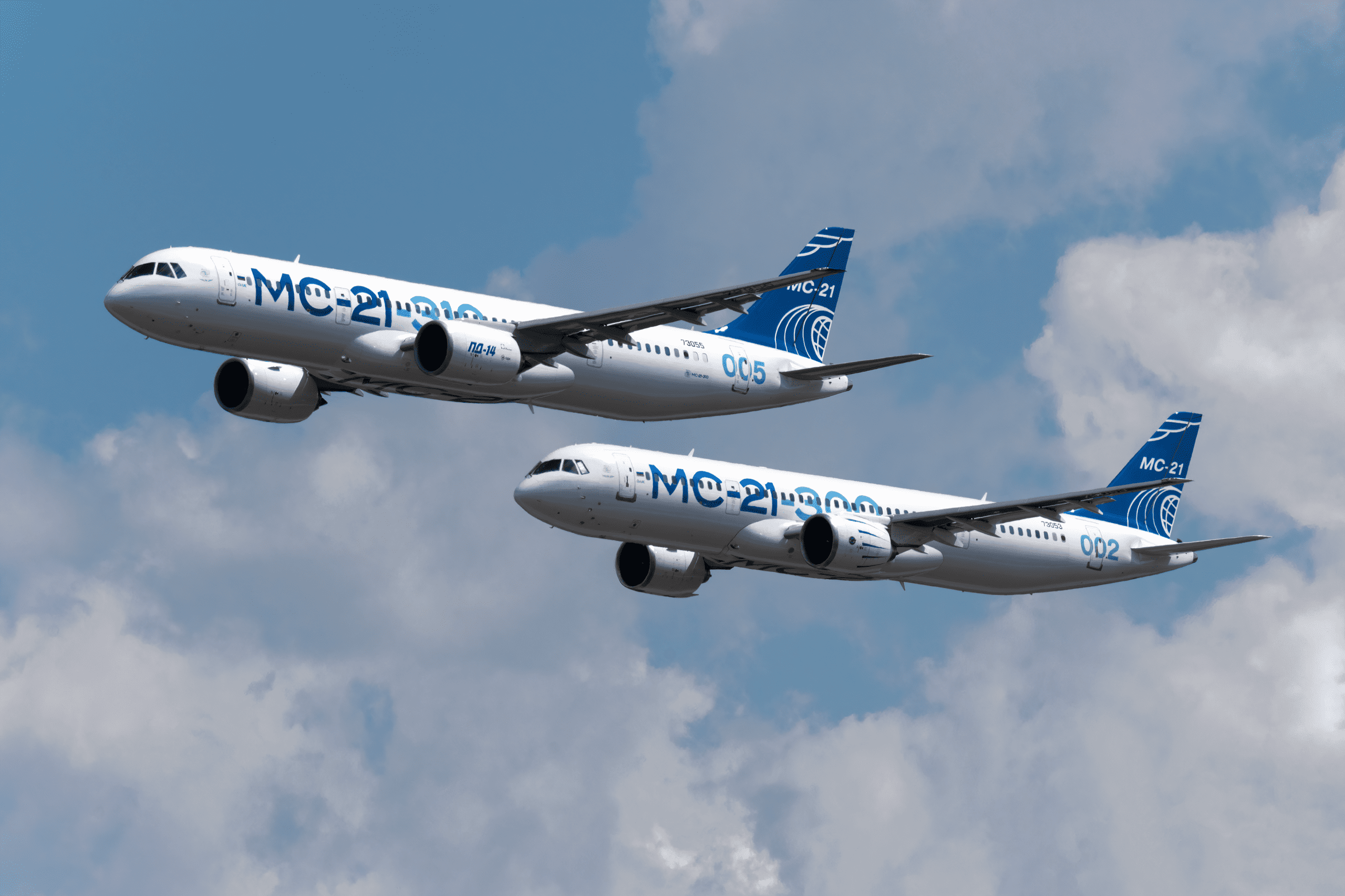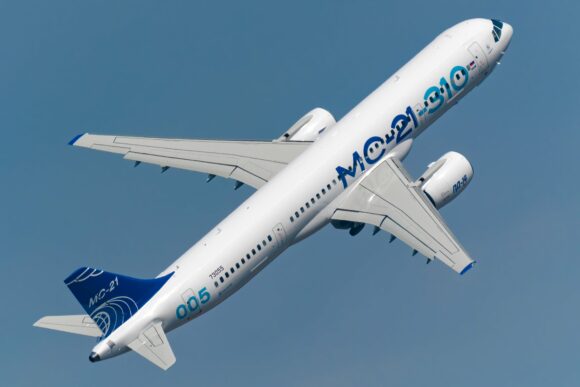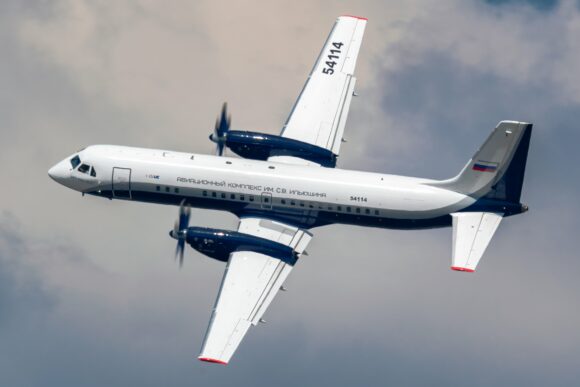
Irkut MC 21
UPDATE – Today on July 20, the first international airshow of any significance since the start of the pandemic kicks off: the International Aviation and Space Salon MAKS 2021. The six-day event at Moscow Zhukovsky Airport will traditionally be a platform for the Russian defense industry to showcase its latest products, including a new fighter jet. But don’t underestimate what civil airplane makers are offering. It’s showtime at MAKS 2021 Moscow airshow.
This year’s airshow has attracted 479 participants, most of them from Russia and former CIS states. Airbus and Boeing will also be there, with the European airframer showing the A350-1000 (MSN059) in Russia for the first time as well as the A220. Don’t forget that lessor Ilyushin Finance has had a firm order for the narrow-body since 2013 and confirmed this in 2018, although no interested lessees seem to have been found. Boeing will not showcase any aircraft except for models on public display.
Other international participants include Safran, De Havilland Canada, Great Wall Industry Corporation of China, Liebherr, MTU Maintenance, Cirrus Aircraft, while the entry list shows Embraer with a remote presence. No delegation of Comac is on the list, nor from CRAIC that is behind the Sino-Russian CR929 wide-body airliner.
Rostec, United Aircraft Corporation (UAC), United Engine Corporation (UEC), Irkut Corporation, and Ilyushin are the Russian heavy-weights to be at Zhukovsky Airport.
Two MC-21s to be showcased at MAKS
Irkut Corporation will showcase two MC-21s, prototype 002 and 005. They rehearsed a joint flypast over the airfield on Saturday, the first time we have seen more than one Irkut in action together. 002 Is powered by Pratt & Whitney PW1400G Geared Turbofan engines, the MC-21-300 version that should get its Russian type certificate before the end of the year.
005 is the MC-21-310 with homemade Russian Aviadvigatel PD-14 engines that first flew in December and has been actively pursuing flight tests since. Only last month, she was ferried to Zhukovsky, from where the MC-21 flight and certification test program is run. Still wearing her green unpainted colors, 005 also received a paint job and now looks almost identical to her P&W sister.
According to UEC, the aircraft has exceeded fifty flight hours since December. Tests of the PD-14 will continue well into 2022 when MC-21 prototype 001 will be converted from P&W GTFs to the Russian engine type to speed up testing and certification.
Irkut MC-21 005, the first with Russian PD-14 engines, has finally received a proper paint job. This is her during a flight demonstration for MAKS 2021 at Zhukovsky. (UAC)
So far, the MC-21 has done more than 500 flights since the maiden one on May 28, 2017. Last week, UAC Director General Yuri Slyusar briefed Russian President Vladimir Putin on the status of all commercial aircraft programs. He stated that Irkut plans to produce 36 MC-21s per year or three per month in 2025, with the plan to ramp this up to 72 in the future. Slyusar said that there is a domestic market for some 600 aircraft in the next ten years, thanks to support from the government. Irkut is preparing European certification of the MC-21-300 with EASA, but a spokesperson told Airinsight last September that this isn’t expected to happen until mid-2022 at the earliest.
No new MC-21 orders announced since 2017
The MC-21 order book currently stands at 175, according to data provided by Irkut. Most orders have been in the book since MAKS 2010, which confirms how long customers have been waiting for their aircraft. As the biggest customer, Aeroflot has orders for fifty Irkuts and had hoped to receive the first in 2019. Delays in the flight test program, partly caused by the effects of the Covid-crisis on staffing, have resulted in further slips in the planning.
Aeroflot will remain the launch operator, with the first 25 MC-21s to have P&W engines and the second batch PD-14s. Aeroflot’s strategic plan that was unveiled last year calls for the purchase of additional homemade aircraft for itself and its subsidiary Rossiya, up from 200 in 2023 to 235 in 2028. If any orders come out of MAKS, a follow-on order from Aeroflot is a likely one. Slyusar told Putin last week that some orders can be expected, without specifying for which types.
Lessor Ilyushin Finance has had fifty orders and options since August 2011, but the last order update dates back to MAKS 2017 when it announced a Letter of Intent with Alrosa Airline for three aircraft. Also announced that year were agreements with Red Wings (firm lease agreement for sixteen), VIM Airlines (LoI for fifteen), Saratov Airlines (LoI for six), while in 2016 AZAL signed an MoU for ten aircraft. Since then, VIM has lost its license, which leaves Ilyushin Finance with firm commitments for nineteen MC-21 plus sixteen intentions. We would like to hear the latest from them this week.
On show at MAKS will be the Superjet RRJ-95B business jet. (UAC)
Expect some SSJ100 updates at MAKS 2021
The MC-21’s little sister, the Sukhoi Superjet 100, will be presented as a business jet version, the RRJ-95B. It will only seat sixteen passengers but they will travel in VIP comfort, of course. UAC has also scheduled a presentation with program updates of the aircraft, which has been around since 2008. While the SSJ100 has received numerous updates in recent years that include aerodynamic tweaks like the sabrelet wingtips, a major step will come from re-engining the type.
Off will go the Russian-French SaM146s, to be replaced by the new Aviadvigatel PD-8 which is based on the PD-14 on the MC-21. UAC will replace more systems from international suppliers with homemade systems, a philosophy that will be also implemented on the MC-21. It’s partly done to strengthen Russia’s own technological and supplier base but also comes as a significant side-effect to US and EU sanctions on Russia.
During his visit with Putin, Slyusar thanked the President for the support of state guarantees that will allow the production of another 59 SSJ100s. He didn’t disclose which airline(s) will take delivery of them.
The Ilyushin Il-114-300 is eagerly awaiting some firm commitments. Any news at MAKS 2021? (UAC)
From elsewhere within the UAC stable is the Ilyushin Il-114-300 turboprop. The first prototype flew on December 16 last year and the second aircraft has been in assembly for many months now. While flight testing seems to be progressing well, the updated version of the trusted Il-114 is still lacking firm orders. State lessor GTLK has only signed a provisional commitment for fifty aircraft.
Hence the statement from Yuri Slyusar to President Putin that “we hope that the market, including measures to support aviation mobility in hard-to-reach regions, will increase the demand for this machine” In other words: Slyusar hopes that the government will support smaller, financially weaker regional airlines and help them buy some Il-114-300s. He said that UAC is ready from next year to build one Il-114-300 per month at the Lukhovitsy assembly site near Moscow.
Future of the Il-96-400M most uncertain
Absent from MAKS as she still has to make her first flight is the Ilyushin Il-96-400M, the stretched and updated version of the -300. The future of the new version is most uncertain. No official updates have been made since April last year when UAC said the first aircraft was in an advanced stage of final assembly at the VASO site in Voronezh.
Last October, reports emerged that the Ministry of Transport intended to redirect funding for the program to other programs as the -400M had failed to attract any customers. Unless orders are forthcoming soon, the project seems doomed.
UEC has started the development of the updated Klimov turboprop that will power the TVRS-44. (Rostec)
New turboprop for new regional airliner
On the commercial engine side, MAKS will also have some news. Apart from the PD-8, which we have discussed before on Airinsight, United Engine Corporation (UEC) will reveal plans for its latest turboprop engine, the Klimov TV7-117ST-02. It is based on the engine that powers the Il-114-300 but has more power at 2.400 bhp. It differs from the -01 version by having a closed oil system, a new generator, an electric starter instead of an air starter, and a new electrical control unit. Fuel consumption will be lower.
The new engine is developed for a new 40-50 seater, the TVRS-44, that is currently being developed by UAC’s Ural Civil Aviation Plant, JZC UZGA, that should be ready in 2025. The design is based on that of the Let 610 and will replace the obsolete Antonov An-24 and An-26B-100, and the Yakovlev Yak 40 as well as older generation De Havilland Canada Dash 8-100s and -200s. UEC intends to have the engine ready for ground tests by mid-2023 so that flight tests can begin by the end of that same year.
UEC will also present the interim results on the PD-35, the high-thrust version of the PD-14 that is likely to be offered on the CR929 widebody. The engine maker announced that it will showcase the fan blades, which are made of polymer composite materials. Smaller blades with the size of a PD-14 have already been tested. UEC says that a demonstrator core of the PD-35 has been produced and various components have been tested.
So it’s showtime at MAKS 2021 Moscow airshow, which will offer a good indication as to where the Russian aviation industry stands.
Views: 12







